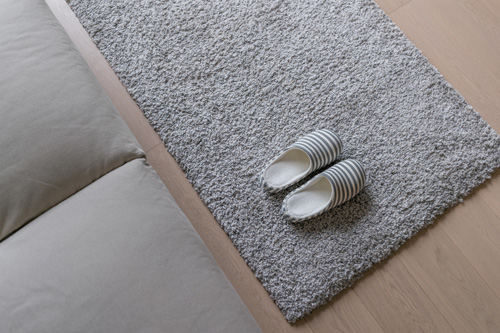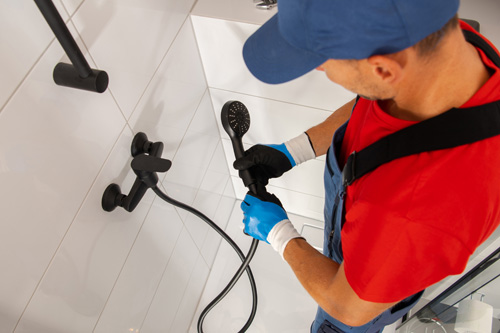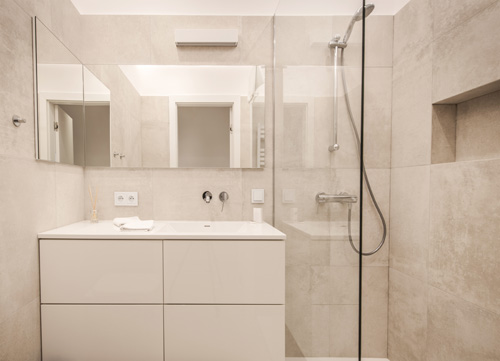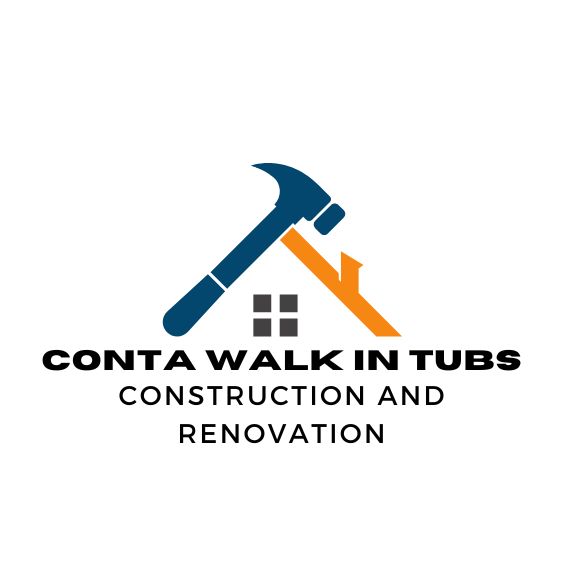Handicap Accessible Bathtubs & Handicap Accessible Showers
- Get Your FREE Quote Today
Fill out the form below and a Conta Walk In Tub team member will get back with you as soon as possible.
100% Privacy Guaranteed.
WALK-IN TUBS, SHOWER CONVERSIONS, BATHROOM REMODELING & MORE!
The installation of handicap accessible bathtubs and showers is essential for providing safe, comfortable, and convenient bathroom access to individuals with mobility impairments. This article will provide an overview of the various types of accessible tubs and showers that are available on the market today as well as a discussion of the benefits they offer. Additionally, this article will discuss the importance of proper installation in order to ensure safety and satisfaction with these products.
Bathtub and shower accessibility has become increasingly important over recent years due to an increase in aging populations or those who have suffered from injuries. Handicap-accessible tubs and showers have been designed to accommodate users by making it easier for them to enter and exit the bathing area without having to climb into or out of a conventional tub. These accessible tubs also feature features such as grab bars, bench seats, low thresholds, adjustable sprayers, and non-slip surfaces which make it easier for individuals to bathe independently while maintaining their dignity.
Finally, proper installation is crucial when considering any type of accessible bath product. It must be done correctly in order to maximize user safety while minimizing potential liability issues associated with improper installation practices. Certified installers should always be consulted prior to installing any handicap-accessible tubs or showers in order to ensure optimal results and customer satisfaction.
Low Thresholds And Non-Slip Flooring
When considering handicap accessible bathtubs and showers, it is important to consider the safety features that will make them a viable option for those with disabilities. Low thresholds are one of these essential components; they allow individuals in wheelchairs or who have difficulty standing up from a seated position to enter into the tub or shower easily. Non-slip flooring is also necessary as it reduces the risk of falls due to slipping on wet surfaces. Walk-in tubs are an excellent option for providing both low thresholds and non-slip floors. These models come equipped with multiple safety components such as non-slip mats, grab bars, and adjustable seat heights. Handicapped showers can be outfitted with low door thresholds, slip resistant floor tiles, and hand rails along walls and around the perimeter of the shower base to provide extra stability while entering and exiting. In addition, walk-in tubs with showers offer added convenience as users do not need to transfer between two separate units but can instead bathe safely within one unit. All these features ensure safe operation when using any type of handicap accessible bathtub or shower.
Risk of Slip

When it comes to handicap accessible bathtubs and showers, one of the most important risks to be aware of is the risk of slip. This is especially true for those with limited mobility who may require the use of a walker or wheelchair in order to access their bathroom facilities.
Slips and falls can result in serious injury and even death, so it is essential that those using handicap accessible tubs and showers take extra precautions to ensure their safety. This includes using grab bars, non-slip mats, and slip resistant floor tiles as well as installing a walk-in tub with a shower or placing a shower seat within the tub or shower itself. By taking these steps, individuals can ensure that they are able to bathe safely and securely without having to worry about slipping or falling.
Grab Bars And Shower Seats

Grab bars and shower seats are essential safety accessories for handicap bathrooms. They provide support to those using wheel chair showers or other accessible showers, allowing a safe and secure transfer from the wheelchair onto the shower seat while providing stability within the shower itself.
Safety grab bars should be mounted at appropriate heights that allow users to safely enter and exit their showers with minimal assistance. These bars can also provide leverage if standing on an unstable surface such as wet tile floors or slippery bath tubs. Some styles of grab bar feature non-slip finishes which help prevent slips and falls in wet areas. Additionally, grab bars come in various shapes and sizes for easy installation in all types of bathrooms.
In addition to grab bars, many handicap bathroom designs include a built-in shower seat or transfer seat inside the shower area. This type of seat allows users who may not have sufficient strength or balance to stand up during bathing time to sit down comfortably within their own private space. The height of these seats can be adjusted accordingly; some models even offer reclining features for added comfort.
Walk In Showers
Walk in showers are an ideal option for those who require the convenience of a wheelchair accessible shower or bathtub. They provide easy access to bathing, with no restrictions on mobility. Walk in tub conversions can be installed into existing bathrooms, allowing users to safely enter and exit their shower without fear of slipping on wet surfaces. Accessible shower stalls can also be constructed outside of the home, so that they may be used by more than one person at once.
Handicapped showers come equipped with features designed to maximize safety and ease-of-use for all users. These include integrated grab bars for added stability and support; transfer benches which make transferring from wheelchairs simpler; handheld shower spray units for increased maneuverability; barrier free showers which minimize potential trip hazards; slip resistant surfaceing such as non-skid mats and tile flooring; adjustable height controls for comfort during use; and specialized faucet designs to reduce water splashing onto the user’s clothes. All these design considerations ensure that walk in showers remain safe environments for people with disabilities or limited mobility.
Benefits Of Walk In Bathtubs
The advantages of walk in bathtubs are unparalleled. Not only do they provide a safe, accessible and comfortable bathing experience, but they also offer a range of features and benefits that make them an ideal choice for people with mobility issues:
- Step in bathtubs allow users to enter the tub without having to step over a rim or ledge as is necessary with conventional tubs. They typically have wide doorways which open inwardly, making it easy to get into and out of the tub safely.
- Seated shower bases provide convenience by allowing users to sit down while washing instead of standing up. This is especially beneficial for those who suffer from balance problems or fatigue easily when standing for long periods. They often feature hand-held showers and adjustable height seats for added comfort.
- Jetted tubs are equipped with hydro massage jets that create air bubbles, providing invigorating massages all around the body. These can be used after exercising or other activities that require physical effort. For some people, jetted tubs may even help alleviate pain caused by arthritis or muscle tension.
- Bubble air tubs work similarly to jetted tubs but use air rather than water pressure to generate soothing bubbles across the skin’s surface. They come in both freestanding and drop-in models and feature high backrests so bathers can relax comfortably while enjoying their treatment.
- Swinging doors add another level of convenience as they provide easier access into the bathroom than standard sliding doors or curtains do. Many swing inwards or outwards at various angles depending on user preference and wheelchair accessibility requirements if needed.
- Roll in showers are designed specifically for wheelchair users which makes them perfect for individuals who need extra assistance getting into and out of the shower area safely each day. In addition, these types of showers typically include built-in seats along one wall which allows bathers to enjoy more time relaxing beneath cascading streams of warm water without having to stand up during their session.
Finally, handicap accessible bathtub and shower accessories such as grab bars, handheld shower heads, elevated toilet seats, safety rails, non-slip mats etc., helps enhance user safety significantly thus enabling everyone including elderly citizens & physically challenged persons bathe independently with confidence & dignity! Here are some popular items available today:
- Grab Bars – Non Slip Mats – Elevated Toilet Seats – Safety Rails – Handheld Shower Heads – Walk-in Bathtubs
Tub To Shower Conversions
Tub to shower conversions are an excellent option for those with limited mobility. Wheelchair accessible showers provide numerous safety features that can be customized for each user’s individual needs. With a variety of sizes available, it is easy to find the perfect solution for your accessible bathroom. For all ADA compliant showers, quality materials and skilled craftsmanship ensure durability and long lasting use.
For custom tub to shower conversions, there are various options such as low threshold entries, hand-held sprays, wall bar systems, fold down seats and more. These additional safety features allow users to get in and out of their shower easily while providing greater stability during bathing. With increased accessibility comes added comfort so you can enjoy your new bathroom without worry or fear.
Handheld Showers
Just as a bridge can connect two sides of a river, so too do handicap accessible bathtubs and showers offer a safe passage for wheelchair users to bathe. For those living with disabilities, these tubs and showers are truly life-changing. They provide an inviting oasis where people of all abilities can relax, refresh, and restore their bodies.
Handheld showers are essential components in the installation of disability shower systems. With ergonomic hand shower sliders and heavy weight shower curtains that enclose entire bathing areas, they ensure that wheelchair users have access to the same luxurious amenities found in mainstream bathrooms. To enhance accessibility even further, many models come equipped with easy-to-reach grab bars as well as adjustable showerheads – allowing everyone to enjoy a comfortable experience regardless of their ability level.
These features not only make it easier for individuals with limited mobility to manage specific tasks on their own but also promote independence by providing them with greater control over their personal hygiene needs. No matter what type of bathroom setup you go for, investing in quality handheld showers is sure to be money well spent!
Financing Options
When considering the installation of accessible bath units, many homeowners find themselves concerned with financing options. Accessible bathroom showers and ADA compliant roll in shower can be expensive; however, there are ways to finance these projects which will give peace of mind and financial stability.
Many companies offer financing options that make the cost of installing barrier free or zero entry showers, as well as other bath fixtures much more affordable. In some cases, customers may qualify for 0% interest loans over a period of time making payments simpler and easier on their budget. Some companies also have special offers such as discounts on labor costs or even free installations depending on what type of project is being undertaken.
These types of financing options allow those who need handicap accessible bathrooms to receive quality products at an affordable price so they can enjoy a safe and comfortable living space without breaking their bank account.
Wheelchair Accessible Showers And Tubs
Easily accessible bathrooms are essential for those with mobility challenges. Wheelchair accessible showers and tubs offer a safe and comfortable bathing experience, enabling individuals to enjoy the independence of taking care of their own personal hygiene needs in the comfort of their home.
When considering bathroom accessibility solutions, there are various options available including: * Accessible shower pans * Accessible shower solution * Accessible tub showers * ADA tub shower stall To further enhance your bathing experience, adjustable shower heads can be installed allowing you to customize the flow rate and direction of water spray as per your preference. Additionally, barrier free showers provide an even easier entry into bathtubs or showers given that they have no threshold which makes it much simpler to get in and out. For people who require more support while getting in and out of the bathtub, transfer benches may be used. They make it much easier to slide over from one side to another due to its movable seat feature. Lastly, grab bars should also be considered when installing wheelchair accessible showers and tubs so users will feel secure when washing themselves without having to worry about slipping or falling.
It is important for safety reasons that all bathroom accessories such as grab bars are correctly fitted by someone knowledgeable about installation standards for disabled access bathrooms. Doing this ensures that these fixtures meet all necessary conditions so that homeowners can feel confident using them safely each time they bathe or wash up.
Slide In Tubs And Wheelchair Accessible Tubs
Slide in tubs are a great option for those needing an accessible roll-in shower unit. They offer the perfect combination of safety, convenience and independence. The low threshold makes it easy to get into the bathtub without having to use a step or ramp. With this type of bathing solution, wheelchair users can easily enter and exit the bath safely and independently with minimal effort.
Wheelchair accessible tubs provide an even more comfortable bathing experience than slide in tubs. These units have been designed specifically for disabled individuals to give them maximum comfort while bathing. This type of bathing unit is equipped with adjustable jets that make it easier to clean hard-to-reach areas such as feet or back muscles. Additionally, most models feature wide seating options so you don’t have to worry about feeling cramped when using your new bathtub. Both types of accessible baths offer superior quality, durability, affordability and ease of installation – making them ideal for any home or commercial bathroom project!

Barrier Free Shower Base

When it comes to accessible bathing products, handicap accessible bathtubs and showers offer the greatest independence and safety. According to statistics, over 80 percent of people with disabilities use a walk-in tub or shower as their primary bathroom access product. There are many different models available that vary in size and design to suit individual needs, including shower threshold. In addition, there are also several accessories such as bath seat cushions, heavy weight shower curtains, and pre-leveled shower bases that can be used for an even more comfortable experience.
For those requiring additional support when using these types of bathrooms, some manufacturers make bathtub lifts which lift users into the air before safely lowering them down into the tub or shower base. This is especially beneficial for individuals who have difficulty standing up from sitting positions due to medical conditions like arthritis or back pain. Additionally, most modern handicap accessible baths feature handrails on both sides of the tub walls for further stability and balance while bathing.
You can also get textured floor. Textured flooring is growing in popularity as an option for creating a safe and accessible bathroom environment. Textured flooring provides added traction to help prevent slips and falls, especially when the floors are wet. This type of flooring is great for those with mobility issues who may be at risk of slipping on a smooth surface. Textured tiles can also be used to increase grip on walls adjacent to the bath.
Overall, by choosing a quality handicap accessible bathtub or shower model designed specifically for accessibility, you will ensure safer bathing experiences and greater control over your personal hygiene routine. With so many options available today, consumers now have ample opportunity to find one that meets all their specific requirements while still providing comfort and convenience.
You can also browse the accessible showers for older people and heavy duty wheelchair accessible showers and tubs. Getting an accessible tubs showers is very important with slip shower surface for a safe bathing experience.
Independent Bathing
Access to bathing reduces risk for elderly and is an important part of everyday life. It helps keep us clean, reduces the risk of infections and illnesses, and even impacts our mental health. For those with limited mobility, access to bathing can be more difficult. In order to ensure everyone has access to this important task, handicap accessible bathing unit and showers are available for your bathing independence. It makes bathing safe and bathing simple for those that need it.
Step in baths are a great way to make access baths for people with limited mobility. They provide the same features as a standard bathtub, but are designed to allow users to step right into the bath without having to climb over a large lip or ledge. Step in baths come in a variety of shapes and sizes, so it’s easy to find one that fits your needs.
A handheld shower head is a great way to make a bathroom more accessible for people with physical disabilities. It allows the user to move the shower head around, so that they can direct the water where it is needed most. This allows them to better control their bathing experience and make it easier to manage their own hygiene needs. Handheld shower heads also come with adjustable settings so that they can be customized to meet the user’s needs. Many models come with adjustable arms and nozzles, making it easier for the user to reach different areas of the body. They also typically feature a wider spray pattern than fixed shower heads, allowing for more coverage of the body.
At Conta Walk in Bath, you can browse the accessible showers for elderly and heavy duty wheelchair accessible showers.
ADA Compliant Roll in Showers are designed to provide a safe and convenient experience for individuals with disabilities. These showers feature a low seat height, allowing users to roll into the shower safely and easily using a wheelchair or other mobility device. Handheld shower wands can be mounted at various heights, enabling those who have difficulty standing or reaching up high to access them. Additionally, these barrier free showers also come equipped with accessible design features such as grab bars and slip resistant flooring that make it worry free for anyone entering the bathroom.
When considering an ADA compliant roll in shower installation, there are numerous factors that must be taken into consideration – from product selection to making sure all of the necessary components meet the requirements set forth by local building codes. A professional bath installer will ensure your bathroom is properly outfitted with ADA approved products so you can rest assured that everyone in your home has safe and easy access when bathing.
For those with mobility issues, an accessible bathing solution is critical to ensure a safe bath time. Handicap accessible showers and handicap accessible bathtubs provide the necessary features so that people of all abilities can enjoy a bath without assistance. ADA compliant transfer showers offer unique solutions for wheelchair users; these have specially designed seats, risers, grab bars and other accessories to help people move from their wheelchairs into the shower safely.
These types of showers are also equipped with non-slip surfaces and low thresholds which reduce the risk of slips or falls. As well as providing support during transfers, they come in different sizes and styles allowing individuals to choose one that meets their specific needs. Not only do they give peace of mind by ensuring safety but allow independence when it comes to personal hygiene. Furthermore, many of them are easy to install and require minimal maintenance making them cost effective too.
Handicap accessible baths and showers enable those living with disabilities to take part in everyday activities such as taking a shower or soaking in a tub comfortably while reducing risks associated with falls or slipping hazards. With this type of bathroom equipment installed, individuals can be sure that they will receive adequate support when using these fixtures on a daily basis.
When it comes to toilets, the ADA has requirements for both their installation height and clearance. The toilet must be installed at a height of 17-19 inches from the floor, with a minimum 16 inch clear space in front of the seat. This is important because it allows users that require assistance or use wheelchairs to easily access the toilet without compromise. Toilets also must have an outward swinging door, as well as a leak proof door seal and shower rod.
Bath drains are also governed by specific standards set forth by the ADA. These include having a drain cover plate which can be removed easily when necessary, as well as making sure there is enough depth in the bathtub so that someone using mobility aids such as crutches do not hit bottom while entering or exiting the tub. Specialty features like grab bars, fold down seats and transfer benches should be included when installing handicap accessible showers and bathtubs, along with additional luxury features such as jets and massage systems if desired. Finally, doors on these baths need to open inwardly instead of outwardly for safety reasons; this includes pull up style doors where possible.
By following these guidelines, homeowners can rest assured knowing they have properly installed bathrooms that meet all relevant ADA requirements and provide individuals with disabilities greater accessibility options than ever before.
Frequently Asked Questions
When it comes to installing a handicap accessible bathtub, the associated costs can vary greatly depending on the specific requirements of the situation. On average, however, one should expect to pay anywhere between $2,000 and $5,000 for a basic installation setup.
The cost could be higher if additional features are required or desired by the customer such as special fixtures or accessories like grab bars. Additional work may also increase the overall cost of installation including tasks such as extending existing plumbing lines or reinforcement of flooring and walls in order to accommodate heavier weight-bearing objects like bathtubs. Furthermore, complex customizations may add additional labor hours which will likely drive up the final price tag.
It is essential that when selecting a contractor for this type of job they have experience with both handicap bathroom safety regulations and building codes so that all necessary modifications are done correctly and meet local standards. Additionally, one should look into whether any warranties are included in the service contract before making their choice. This way customers can rest assured that their investment is protected against any unexpected issues down the road.
Irony is often used to emphasize an idea, and this is especially pertinent when discussing the question of whether all handicap accessible bathtubs and showers are ADA compliant. While it may seem like a simple yes or no answer on the surface, in reality there is much more complexity involved when answering this query.
As safety bathroom bath installers, we must be aware of the many standards that are set forth by the Americans with Disabilities Act (ADA) for accessibility requirements both inside and outside of bathrooms. A key element to look out for when determining if something meets ADA compliance guidelines is how easily someone who has limited mobility can maneuver within a given space; does the person have enough room to move around freely? Does he/she need assistance from another person? These are important questions to consider when assessing any handicapped-accessible bathing facility.
In addition to these criteria, one should also take into account other features such as grab bars and seating options which provide further support while using the tub or shower. All fixtures must meet certain specifications as they relate to size, shape, placement and material composition so as not to create additional risks for those using them. Furthermore, any non-slip surfaces near wet areas should be inspected regularly for wear and tear – this helps maintain a safe environment overall. It’s clear that adhering to ADA guidelines ensures everyone has equal access regardless of their physical abilities.
When considering a bathtub, it is important to understand the differences between a handicap accessible bathtub and a regular bathtub. Handicap accessible bathtubs are designed with safety features that allow people with limited mobility or physical disability to use them more easily than a standard tub. These safety features include grab bars, adjustable seat heights, slip-resistant surfaces, low thresholds for easy entry and exit, and wider door openings.
Regular bathtubs do not have these additional safety features and may be difficult or even dangerous for some individuals to use due to their lack of accessibility. Additionally, ADA compliance dictates specific requirements regarding dimensions, flooring materials, fixtures placement, and other factors which must be taken into consideration when installing handicap accessible showers and baths. As such, it is essential for homeowners to discuss their options with an experienced bathroom safety installer who can provide guidance on selecting the best solution for their needs.
Have you ever wondered what it takes to install a handicap accessible bathtub or shower? The process can be tricky and requires careful instruction to ensure the safety of those using the bathroom. With that in mind, are there installation instructions for handicap accessible bathtubs and showers?
Installing a handicap accessible tub or shower starts with making sure the area is properly prepared for the project. This includes checking the walls and floors for any damage, as well as ensuring that all measurements have been taken correctly. Once this preparation has been completed, it’s time to begin installing the actual fixtures. Depending on which type of fixture is being installed, different parts may need to be assembled before they can be put into place. For example, some models require cementing or bolting down while others simply fit inside an existing frame or base.
Safety is paramount when working with these types of installations, so it’s important to follow all directions provided by both manufacturers and local codes carefully. Additionally, professional plumbers should always be consulted if issues arise during installation due to their expertise in dealing with such projects safely and efficiently. By following all guidelines closely, individuals can rest assured knowing that their handicap-accessible bathtub or shower will provide years of reliable use without issue.
When constructing a handicap accessible bathroom, there are several special considerations that must be taken into account. From the layout of the room to the materials used in the construction process, certain requirements exist for creating an environment conducive to those with disabilities. The goal is to ensure safety and optimal mobility within the space while meeting local building codes and regulations.
One important aspect of any handicap accessible bathroom is its size. Depending on individual needs and regional codes, bathrooms should generally provide at least five feet of clearance between fixtures such as toilets and showers or other obstacles like cabinets and counters. Additionally, doorways need to be wide enough – usually three feet – and have adequate maneuvering space inside once opened. Other modifications may include grab bars near bathtubs or showers, non-slip flooring surfaces, lower sinks, higher toilet seats, and lever-style faucets.
For this reason, it is essential that installers understand both local building codes as well as the specific requirements of their clients when constructing a handicap accessible bathroom. Meeting these criteria can help create a safe space where individuals with limited mobility are able to feel comfortable while moving around without risk of injury or further limitation.
When constructing a handicap accessible bathroom, there are several special considerations that must be taken into account. From the layout of the room to the materials used in the construction process, certain requirements exist for creating an environment conducive to those with disabilities. The goal is to ensure safety and optimal mobility within the space while meeting local building codes and regulations.
One important aspect of any handicap accessible bathroom is its size. Depending on individual needs and regional codes, bathrooms should generally provide at least five feet of clearance between fixtures such as toilets and showers or other obstacles like cabinets and counters. Additionally, doorways need to be wide enough – usually three feet – and have adequate maneuvering space inside once opened. Other modifications may include grab bars near bathtubs or showers, non-slip flooring surfaces, lower sinks, higher toilet seats, and lever-style faucets.
For this reason, it is essential that installers understand both local building codes as well as the specific requirements of their clients when constructing a handicap accessible bathroom. Meeting these criteria can help create a safe space where individuals with limited mobility are able to feel comfortable while moving around without risk of injury or further limitation.
Conclusion
Handicap accessible bathtubs and showers provide safety, comfort, and convenience for those with mobility impairments. They are an invaluable asset to many individuals who need assistance getting in and out of the tub or shower. Installation costs vary depending on the type of bathtub chosen; however, most handicap accessible baths cost between $1000-$5000 dollars to install. It is important that each installation meets ADA standards as these ensure a safe environment for everyone using the bathroom.
The process of installing a handicap accessible bathtub requires knowledge and skill from experienced professionals. Not only do they have to understand how all the pieces fit together but also properly secure them so they will last long-term without needing repairs. As such, it’s important to hire someone who has experience working with this type of product. Additionally, there are certain requirements that must be met before beginning any installations, like ensuring proper ventilation and access points for wheelchair users.
Installing a handicap accessible bathtub can not only improve quality of life but often increase home value too. This investment in independence allows people who are limited by their physical abilities to enjoy the same luxuries as anyone else – including taking hot relaxing baths or invigorating showers. With professional help, it’s possible to get just what you want while ensuring your safety and satisfaction every step along the way!

